🍥 Lac Harvesting
Learn about Lac Secretion, Lac Composition, Scraping and Processing of Lac, Economic Important, Natural Enemies of Lac, NISA
Which of the following statement is incorrect?
Lac Secretion
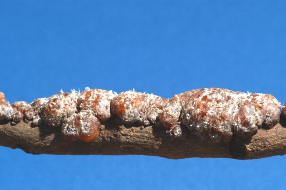
Lac Encrustation
- Lac is a resinous substance secreted by certain glands present in the abdomen of the lac insects. Resin glands are situated all over the body except near the mouth parts. Two breathing pores and anus.
- The secretion of lac begins immediately after the larval settlement on the new and tender shoots. This secretion appears first as a shining layer which soon gets hardened after coming in contact with air. This makes a coating around the insect and the twig on which it is residing.
- As the secretion continues the coating around one insect meet and fuses completely with the coating of another insect. In this way a continuous or semi-continuous incrustation of lac is formed on the tender shoots.
Lac Composition
| Lac Resin | 75% |
|---|---|
| Waxes | 6% |
| Dyes | 5-6% |
| Albuminous Material | 12-13% |
Scraping and Processing of Lac
- Lac cut from the host plant is called as “stick lac”. Lac can be scraped from the twigs before or after the emergence of larvae.

- If it is used for manufacturing before the emergence of larvae, the type of lac produced is called as “Ari lac”. Therefore is an early harvested lac.
- If it is used for manufacturing purpose after swarming of larvae has occurred, the lac is said to be “Phunki lac”.
- The scraping of lac from twig is done by knife, after which they should not be exposed to sun.
- The scraped lac is grinded in hard stone mills. The unnecessary materials are sorted out.
- In order to remove the finer particles of dirt and colour, this lac is washed repeatedly with cold water.
- Now at this stage it is called as
Seed lacand is exposed to sun for drying.
- Seed lac is now subjected to the melting process. The melted lac is sieved through cloth and is given the final shape by molding.
- The final form of lac is called
Shellac. Colour or different chemicals may be mixed during melting process for particular need.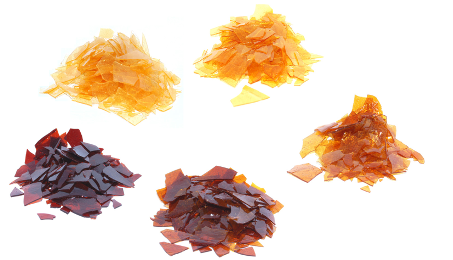
- Shellac present in the form of flakes is the finished product of lac commonly used across the world. Shellac is the purified lac usually prepared in the orange or yellow flakes.
- Lac is marketed as
shellac. It is the product of commerce. - If the molten fom of lac is allowed to solidify in the form of discs then it is called
button lac.
Economic Important
- Raw lac is the source of three valuable products i.e. resin, dye and wax.
- Lac cultivation is an important source of income for livelihood of the forest and sub-forest dwellers of Jharkhand, Chhattisgarh, Madhya Pradesh, West Bengal, Maharashtra, Odisha and parts of Uttar Pradesh, Andra Pradesh, Gujarat and NEH region.
- Lac production is highly labor intensive process and provides employment to both men and women dwelling in forest and sub-forest areas of these states.
- It is a highly remunerative crop, paying high economic returns to the farmers and also to foreign exchange of the country through its export.
- Commonest use is in polishing wooden furniture. The granules are dissolved in spirit and then are applied in very thin layers on the wooden surfaces
- In sealing parcels, packets and envelopes
- Lac resin is used in food processing industry; cosmetics and toiletries industry; varnish and printing industry; coating of fruits and vegetables; electrical industry; leather industry; adhesive industry; pharmaceutical industry; perfumery industry; miscellaneous applications.
- Lac dye (erythrolaccin) has been used in India as a skin cosmetic and dye for wool and silk.
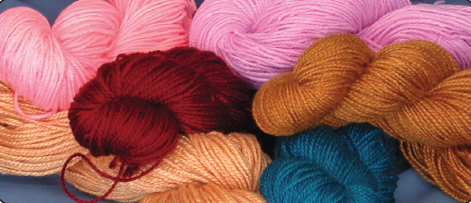
Wool dyed with Lac Dye
- In China it is a traditional dye for leather goods. The use of lac for dye has been supplanted by synthetic dyes.
- It is used in medicine to protect liver and to fight obesity. Lac is used in food, confectionery and beverages industry and textile industry. Lac is used in the manufacture of toys, ornaments, electrical insulating materials, varnishes, polishes, lithographic inks, shoe polishes, sealing wax, etc.
- It is used in electric insulations, lamination of papers, hat proofing and coating of pictures and fossils.
- Lac is used for manufacture of tailors chalks, crayons, bottle sealers, lipsticks, enamels, printing inks, gramophone records and in fireworks.
NATURAL ENEMIES OF LAC
- Some chalcedonic and lepidopteran insects lay eggs inside the mists. The nymphs of lac insects are eaten up by their larvae.
- Proper selection of seed lac, killing of predator eggs in harvested lac, and use of insecticides greatly minimise damage to the crop.
- Predators: Two moth predators cause a lot of damage to lac.
- Eublemma amabilis (the white moth)
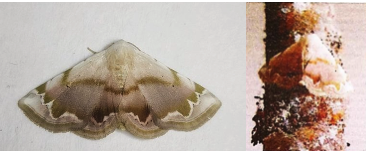
- The White enemy of lac: Eubiemma amabilis (Noctuidae)
- The larva is dirty white in colour and tunnels through the lac encrustation and feeds on larvae and adults. It pupates within the tunnel and adults after emerging lay their eggs near the lac encrustation.
- Holcocera pulverea (the blackish grey moth)
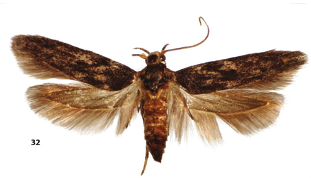
- The Black enemy of lac: Holococera pulverea (Blastobasidae, Lepidoptera)
- The damage by the brownish larva is similar to the above species. Pupa is slightly bigger and yellowish-brown. They not only feed on lac insects but also destroy the lac produced by them.
National Institute of Secondary Agriculture (NISA)
- It is in
Ranchi, Jharkhand. - Established on September 20, 1924, Indian Lac Research Institute (ILRI) had been the nodal Institute at national level for providing research and development support to all aspects of lac such as production, processing, product development, technology dissemination, information repository and national and international cooperation.
- The mandate of this Institute was therefore, expanded to include all natural resins and gums, besides lac and the name of the institute was changed to Indian Institute of Natural Resins and Gums (IINRG) on September 20, 2007.
- To increase the income of farmers, value addition of the produce and utilizing the crop residues is attaining high priority.
Secondary Agricultureis high value addition to primary agriculture. It helps in using all parts of an agricultural produce (e.g. crop residues, animal hair, bones, viscera, etc), processing to enhance shelf-life, increasing total factor productivity and generating additional jobs and income for farmers. Certain alternative agriculture activities like Lac culture, beekeeping, mushroom cultivation, agri-tourism, etc, also fall under the ambit of secondary agriculture. By-products from agricultural crops, if processed appropriately for deriving industrial products could pave a way in getting better economic returns from agriculture.- Keeping in view the importance of secondary agriculture in rural industrialization in order to improve farmer’s income, it was proposed to further widen the mandate of the IINRG. Therefore, the Governing Body of ICAR Society in its 256th meeting approved the proposal and the new name of the Institute as National Institute of Secondary Agriculture (NISA). Consequent to this decision of the Council, Indian Institute of Natural Resins and Gums has been rechristened as National Institute of Secondary Agriculture w.e.f. September 20, 2022.

References
- https://nisa.icar.gov.in/
- https://agritech.tnau.ac.in/
- Wikipedia
Which of the following statement is incorrect?
Lac Secretion

Lac Encrustation
- Lac is a resinous substance secreted by certain glands present in the abdomen of the lac insects. Resin glands are situated all over the body except near the mouth parts. Two breathing pores and anus.
- The secretion of lac begins immediately after the larval settlement on the new and tender shoots. This secretion appears first as a shining layer which soon gets hardened after coming in contact with air. This makes a coating around the insect and the twig on which it is residing.
- As the secretion continues the coating around one insect meet and fuses completely with the coating of another …
Become Successful With AgriDots
Learn the essential skills for getting a seat in the Exam with
🦄 You are a pro member!
Only use this page if purchasing a gift or enterprise account
Plan
Rs
- Unlimited access to PRO courses
- Quizzes with hand-picked meme prizes
- Invite to private Discord chat
- Free Sticker emailed
Lifetime
Rs
1,499
once
- All PRO-tier benefits
- Single payment, lifetime access
- 4,200 bonus xp points
- Next Level
T-shirt shipped worldwide

Yo! You just found a 20% discount using 👉 EASTEREGG

High-quality fitted cotton shirt produced by Next Level Apparel